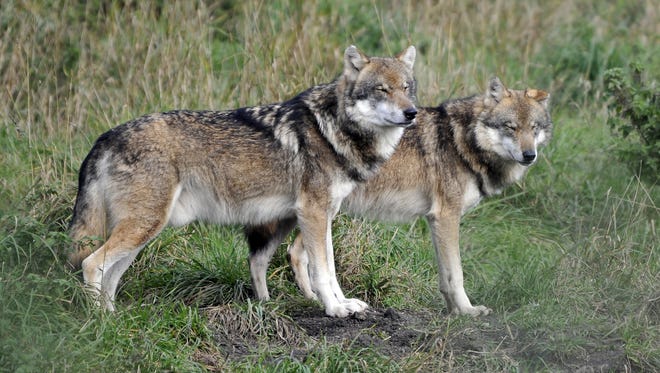Wildlife damage programs, a complicated entity

MANITOWOC – What's the difference between deer, bear, Canada geese, wild turkeys, elk, cougars, sandhill cranes, and wolves and animals such as raccoons, blackbirds, starlings, and coyotes?
It's that livestock and crop damages caused by the eight species in the first listed group are eligible for compensation payments in Wisconsin through programs overseen by the Wildlife Services division of the U.S. Department of Agriculture's Animal and Plant Health Inspection Service (APHIS).
APHIS wildlife specialist Brian Maedke, who covers Manitowoc, Calumet, Kewaunee, and Outagamie counties, outlined the complex Wildlife Damage Abatement and Claims Program (WDACP) to attendees at the Manitowoc County Forage Council's 2020 annual meeting and program.
The motto of the Wildlife Services division is to protect people, agriculture, and wildlife — a three-part goal that results in inevitable conflict in many cases — a conflict that the federal program is designed to manage, Maedke indicated. He noted that the goals include limiting the damage caused by wildlife without increasing wildlife mortality.
Because it's not always possible to meet both of those goals, WDACP was established during 1983 in Wisconsin, being overseen the state's Department of Natural Resources, Maedke pointed out. Within the state, the program is administered by 16 counties (mostly in the far north, southwest, and northeast) and by contract with Wildlife Services in all but two of the state's other 56 counties.
Maedke noted that claims attributed to elk, cougars, and wolves were added to the program in 2012. WDACP is funded with $2 to $4 surcharges on hunting licenses along with $12 from the sale of each antlerless deer bonus tag.
Rules for eligibility
To be eligible for a loss claim on a crop, the applicant must be the crop owner and have control hunting access with one of three options — open public hunting, a managed hunting access for a minimum of two persons per 40 acres of hunting land, or participation in Wisconsin's ACT 82 which provides a deer shooting permit, Maedke explained.
Maedke finds that ACT 82 is the most popular with 13 hunting permits in Manitowoc County alone for 2020. He stated that the open public access hunting options tend to hinder landowner participation because they wouldn't have control on who enters their property.
In addition to the hunting provisions, either Wildlife Services or the administering county officials must be contacted within 14 days after crop damage is first noticed every year and abatement practices must be observed, Maedke explained. Approved claims for losses carry a deductible of $500 and have a maximum of $10,000 per year, he noted.

Abatement practices
Regarding sandhill crane damage, Maedke indicated that a hunting period is needed to support a claim and suggested that landowners being affected obtain a permit for shooting to protect their corn early in the growing season. Use of the seed treatment bird repellent Avipel, supplied by Bio-Resources of Manitowoc, is recommended as an abatement practice, he added.
Although abatement measures are required by WDACP, the use of cannons or other sound devices isn't working, Maedke admitted. For blackbird damage, which is most common with corn or also possible with small grains, he mentioned shooting as a possibility.
A related Wildlife Service form of assistance, which was derailed in 2019 due to an improperly manufactured product, is the placement of a poison of control European starlings at farms, Maedke reported. Farmers must pay for that service.
To encourage seagulls to move to a different place, Wildlife Services can offer help, including the issuing of a permit, Maedke stated. For resident Canada geese, populations can be controlled with the oiling of eggs to prevent hatching, he added.
Wildlife Services can offer assistance in the Green Bay area on the double-crested cormorants which dine on perch and can kill trees with their droppings and with the colonies of mute swans which prove to be invasive and aggressive birds, Maedke stated.
As as abatement, temporary fencing can work in some settings, Maedke continued. To keep Canada geese from becoming long-time guests in small ponds, he suggested stringing fishing lines across the body of water.

Contending with larger animals
To deter deer and elk, strong permanent fencing for which WDACP can cover 25 percent of the cost is advised, Maedke stated. An accompanying recommended practice, begun in 1999 and funded by WDACP and for which 90,000 deer have been processed into 3.7 million pounds of ground venison is the state's donation program for extra deer, he remarked.
Livestock owners who suffer losses due to bear or wolf attacks need to have those incidents investigated promptly, Maedke emphasized. For whoever can identify a coyote from a cougar, shooting is permitted.
Feral hogs, which are notorious carriers of disease, should be shot on sight, Maedke advised. In what might be a surprise to area residents, he said some have been found in Manitowoc County although much of the state's population is in the southwest counties.
“Call us for help with starlings and seagulls,” Maedke suggested. The numbers are (920) 324-4514 for the district office at Waupun, 1-800-433-0633 for southern Wisconsin, and 1-800-228-1368 for northern Wisconsin.